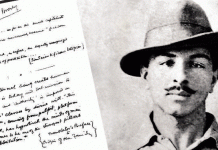The rising instances of intolerance and fragmentation in the national fabric are a result of mobocracy and the failure of the nation-state to ensure that diverse cultural and religious populations are ensured dignity and justice.
Deepali Aparajita is a PhD Scholar at the Centre for the Study of Social Systems, JNU/New Delhi.
Twinkle Siwach is a PhD Scholar at the Centre for Media Studies, JNU /New Delhi.

[dropcap]T[/dropcap]he Supreme Court of India, in a judgment on 17th July 2018 asked the parliament to draft new laws on mob lynching condemning ‘mobocracy’. Recent trends in the circulation of fake news, images, and videos on social media platforms have contributed largely to the instigation of intolerance and polarisation on communal lines. Hate-speeches against the other religious/caste communities have increased the instances of mob lynching and cow vigilantism.
A three-judge bench headed by Chief Justice Deepak Misra and comprising Justices A.M Khanwilkar and D Y Chandrachud, asked the government to provide “preventive, remedial, and punitive measures” to deal with such offences. In a democratic setup, given the amount of chaos on the one hand and faith upon the constitution on the other, the nation-state has to ensure as well as protect the rights of all the citizens and consider them equal. The horrendous acts of violence like these not just violate the law of the land but also invoke the violation of fundamental human rights. The verdict is a 45 page critical document of rising silent spectatorship of the citizens on mob violence. It points out “No individual in his own capacity or as a part of the group, which within no time assumes the character of a mob, can take law into his/their hands and deal with a person treating him as guilty”.
Mobocracy is becoming the new norm in India. It can be crudely defined as the act of violence or attack by a mob on an individual without any adherence to the law of the land or principles of natural justice. The reliance of the public on the law has turned into the public taking the law in their hands. The people who turn into a ‘mob’ every other second are fearless, emotionless, robots in the shape of hate-mongers who do not consider the other as human, rather seizes to think, and targets upon them as the ‘enemy’. The capacity to think and reason out takes a backseat leading to irrational human emotions.
The mob therefore has no ‘mentality’ apart from spreading violence and hatred towards the ‘other’ community. The sacrosanctity of humanity dies at the parody of hunger for power and dominance over the other. It is then, that the social order begins to crumble, ushers disorder, and mocks collective consciousness. Collective consciousness has found an important place in legal lexicon in the recent times.
When French sociologist Emile Durkheim wrote in 1893 about collective consciousness, he was identifying two forms of solidarity namely, mechanical and organic. The advance societies would witness mechanical solidarity, based on rigid, religious bonds, being replaced by organic solidarity where the individual attains the central role and solidarities would arise out of given set of rules and sanctions. What we however observe with respect to cases of mob violence is that individuals located within a modern complex society chooses to act in ways that are typical of mechanical solidarity.
This article highlights some of the critical issues that surface in contemporary society as we note the transition of the Indian democracy to ‘mobocracy’.
Role of Media and the New Information Society
The term ‘Information Society’ was used by Manuel Castells, in juxtaposition to ‘informational society’ which indicates attributes and forms of social organizations and the way they generate, process and transmit the fundamental sources of productivity and power as per the changing technological needs of any society. Castells in his Network theory opined that the world is reconstituting itself around a series of networks, strung across the globe based on advanced communication technologies. He observes the transformation of material culture at the end of the twentieth century by a ‘new technological paradigm’ that is organised around new information technologies. It is in this context, that the emergence of ‘WhatsApp University’ and the new human relations based on the internet is to be understood and analysed.

Historically, India has been a witness to some of the worst forms of mob violence, seen in the Sikh riots of 1984, Nellie Massacre, 1983, Gujarat riots of 2002 and Muzaffarnagar riots 2013. However, the recent upsurge in cases of lynching, highlight some very critical aspects of Indian society. The increased incidence of mob violence, since 2015, has led to the National Crime Records Bureau (NCRB) releasing a database on the subject, first time ever.
The recent years have seen a regime change not only at the level of the Central government but also within various states. While it is essential to point to the failures of governments in upholding the law of the land, it is also necessary to point to the idiosyncrasies of the present context. The dominance of social media over other forms of media is one of them. Social media fits perfectly well to channelize the angst that captures the youth today. So much so, that a Facebook post or a WhatsApp message can trigger emotions and actions. It is peculiar that a ‘forwarded’ message would acquire so much sanctity irrespective of the authenticity of its content. In the recent cases of mob violence, we have witnessed the trend of forwarding the message without understanding its complexities that ultimately leads to the public rage against a person or a community. The unchecked unregulated circulation of information poses a great risk in the larger ambit of knowledge construction in a society, especially in case of a region, which consists of diverse population and multifaceted identities.
Ideology becomes the central force to shape consciousness of an individual. In the Marxist analysis of the media theory, the power resides in the hands of a “few” (the one who controls the funding and processing of news in the market). The different stakeholders might be there in the process of the making of an information order but it is the ideology which is at target to mobilize the ‘public opinion’. It is often the dominant ideology which imposes the unequal and exploitative ways of oppression against the ‘other’.
The corporate media agencies maintains and fulfills the aims of the dominant ideology. The social media sites are producing a large amount of data on everyday basis, and it has its limitations unlike print media that can be questioned or critiqued for its content but on social media, everyone is its own editor. Hence, arises the issue of fake news and manipulation of public opinion. Also, social media has penetrated into households to a great extent, it has access to educationally backward audiences as well, compared to the print media as all they ask us to do is ‘click’ and ‘share’.
Death of reason?
Speaking of media and information dissemination one cannot overlook how there has been a clear diversion from ‘reason’, something that any society acquires en route progress. Take for instance the popularity of shows and series on supernatural elements gaining high TRPs. Viewers would sit in their comfortable homes and watch the most unscientific of shows on their advanced television sets. Similarly, hateful messages would be read and forwarded conveniently on smart phones sometimes knowing and often not knowing or internalizing their impact. Here, lies a clear irony, while on the one hand devices of the modern, technologically advanced society are being used as tools to propagate a point of view in a ‘globally network society’ and on the other, anything and everything can be searched, viewed, and shared that is bereft of reason. There are the benefits of ‘new media’ but there is a dark side to it too, as we have witnessed in the cases where hoax messages are circulated to intensify violence on the streets.
So while we can merely criticise governments and regimes over the failure to maintain law and order we need to take a step further and look into how we as a society have imbibed the very ethos of the modern world, without reflecting upon the ethics of humanity.
The Paradigm Shift; State and the Citizen
Precisely, there is a negligible focus on the issues directly concerning the everyday lives of its citizens. It is the utter unfortunate times that the citizen is constantly living under the fear and state of suspicion in his own peripheries. It is a matter of surprise that there are no voices to defend the democratic rights when there are pressures under the influence of the state to succumb to the regressive instances.
The social media platforms may also become a display arena for the counter hegemonic voices to rise in solidarity with the minority communities. The information available on digital media is if diversified, one could equally look for a democratic use of the same space to do well, ‘in the interest’ of the society. Subsequently, media, the fourth pillar of the democracy should stay out of the purview of intervention of the state, as it must participate in both representing and analyzing the state. They must filter the news and check its authenticity before circulating the ‘news’ or the ‘video’ as it is the distorted facts which triggers the violence on the streets. The interests of the owners of media groups masks out its own structural oppression. The role of the journalists becomes necessary in the way they function, they have to retain the strength to highlight the voices of resistance among the exploited class.
Collective conscience in the present Indian context is seen to be manipulated by the ruling class using new media as a very powerful tool. We see the emergence of a mob culture driven by the absence of objective thinking and there is no regard for laws and sanctions. We need to question the nexus between the ruling class and the bourgeoisie that controls information circulation in media. The virtual monopoly of capitalist class on different forms of media creates a vicious circle of propaganda which might throw larger questions in the air, answers of which are to be hunted in critical academic engagements and further discussions at various other public forums.














